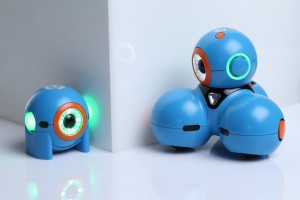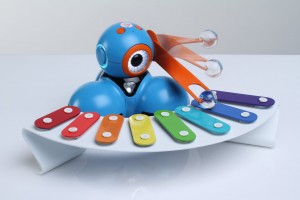
In addition to playing hide-and-seek with each other, Bo and Yana will teach your kids to code, says Play-i.
The robots are coming this Christmas, coming to teach your six-year-old to code.
Play-i, a Mountain View, CA-based company, plans to start shipping Bo and Yana, two adorable robots kids can program wirelessly with a tablet or smartphone.
Based on intense rounds of play testing and user testing the robots are built to balance fun with the challenge of programming, said Vikas Gupta, Play-i CEO and founder.
The product, that already has 16,000 orders, has evolved a lot since their initial idea of creating a kit so children could build a robot.
“We wanted to make the robot wirelessly programmed. The reason that was was because we found that children, universally, hated wires. Even if was putting something together from one connection to another, wires made it not fun,” Gupta said. “The moment we made it wirelessly programmed—The firs time the child takes an iPad, touches the screen and the robot starts to move, you see their eyes light up, you see something magical happen and those magical moments are what we found make the product engaging.”
Listen to the full conversation here:
The follow is an edited transcript of the interview:
gamesandlearning.org: So how do you guys describe the Play-i project?
Vikas Gupta: So we see ourselves… our focus is on engaging children at a young age and our specific mission that we are on is to engage them with learning to program, learning computational thinking at a young age.
And we found that the best way to engage children is with a physical, tangible product which is what led us to creating the robot that we have. In some ways you can consider it a toy, but for us we call it a robot and the robot has a name and that is what we stick to.
Wherever we go in the future, our focus stays with the company. We want to build products that engage children with that learning skill in mind which is how to learn programming in the world of today…
gamesandlearning.org: How did you get the robot as the best way to get to the skills they needed to be able to program?
Vikas Gupta: So when I first started the company we did a lot of research on how do children learn at a young age…. When I heard that children were learning programming from first grade for me that felt very young. How does a child at the age of 7 or 8 learn programming? I learned programming for the first time when I was 14 or 15.
Then I saw research out of MIT and Tufts University which showed that kids are capable of learning programming concepts at a young age – at the age of 5 or 6.
The challenge for these kids is they always lacked tools to make it accessible for them. The same research said the best way for kids to engage and to get these concepts of programming accessible to them is through tangible interactions, through something physical that they interact with…
Our first prototype involved a modular kit where they could build a robot and while they are building they learn programming. We found there were shortcomings there and then we moved to a model where we give the child a robot and we then invite them into the world of programming using a touch device, a tablet or an iPad. We found that was much more effective in engaging children.
For us the competition isn’t really other toys. The competition, at the end of the day, for a child’s attention is the iPad and the iPhone and the tablet…
gamesandlearning.org: One of the concerns we hear from parents is this will just add to screen time for their kids. Was that part of your thinking as well in developing a robot or was it just that this was the best way to teach programming concepts?
Vikas Gupta: So I think it’s a combination. First we thought was what is the best way to engage children with programming. That was the primary motivation. I think, as a parent myself, I limit the screen time for my child and there was the notion that if we make it purely software then we really aren’t doing justice for our children because we are giving them more reasons to be limited to a small screen.
Doing something tangible was really interesting because it draws the child into a three dimensional world around them and doesn’t limit them to be in front of a screen all of the time.
gamesandlearning.org: How did you break down coding into concepts that could be taught to a five-year-old?
Vikas Gupta: …There are two parts to it. How do you make it fun and engaging to children so a child can engage with it for a long period of time? There the goal was how do we make it fun? How do we make it a character, a personality, something a child will do without being told to do it?… That’s where we spent a lot of time trying to figure out how do you build it a fun experience. And there it basically involves how do you build a personality into the robot? We invested a lot in the way it looks and features of the robot to make that happen. For example being able to move the head independent of the body gives it a lot of character…

Bo plays the xylophone
The second part is we take those aspects of learning to program and we try to drill down to what are those concepts and how do children learn them? And we want to put them in the context of things that children want to do. So, for example, with the robot one of the aspects is music and dance. And how do we weave those concepts of learning with music and dance? So for example with the xylophone accessory that we have, we can program the robot – robot Bo – to play the xylophone. And how you program it is where a lot of learning happens. But there there is no text to use, there is no syntax.
It’s all basic programming concepts and there is the question is how do we weave those challenges, how do we weave those tasks while trying to keep a good balance between what is fun and what is a challenge…
gamesandlearning.org: What did the development process look like?
Vikas Gupta: It has evolved quite a bit. For us, the parents and children we interact with at play testing and user testing have been very critical in our development and thinking process. So when we first started the product and the company we were building a modular kit and there the goal was the child would build the robot. And we found when we were doing play testing with kids it was never really fun. It was a lot of work and the children felt they were being pushed to do this rather than trying to do this by themselves.
The other thing we found is parents did not find it fun, they did not find it engaging… There were three things we decided we needed to innovate on.
It needed to be fun from the very first moment of interaction. The very first interaction needs to be fun and engaging. If you open a box and a thousand pieces fall out and you have to build something for three hours before you get a robot that’s a very delayed gratification. And when you want to target kids as young as 5, 6 or 7 that’s a very challenging task and we lose kids really early.
Second thing we realized was for us to make it an effective product it needed to be affordable to a large number of people. So we needed to keep the price down and the challenge with a modular kit was if you want to build a smart robot construction kit it gets expensive very quickly…
Finally we wanted to be accessible to a young child. We wanted it to be something that a five-year-old a six-year-old a seven-year-old could play with and have fun with and not necessarily only the older kids…
At every stage of development, even when the robot was a mess of wires and wheels we actually were testing with kids because we wanted to get feedback from every single aspect we were investing in. So as an example, we wanted to make the robot wirelessly programmed. The reason that was was because we found that children, universally, hated wires. Even if was putting something together from one connection to another, wires made it not fun. The moment we made it wirelessly programmed—The first time the child takes an iPad, touches the screen and the robot starts to move, you see their eyes light up, you see something magical happen and those magical moments are what we found make the product engaging…
gamesandlearning.org: What does success look like?
Vikas Gupta: We are driven by one goal: we want this to really work for children. Like, I want this robot, when it gets in the hands of a child or a parent, I want them to feel like this is a product that they enjoyed and they paid the amount – they paid $200 for this robot – not only was it more valued then they would have ever imagined, but it was something that was so engaging for their child that they want to tell everyone else about it.
And then the other part where we will find whether we are successful is if we find that children are going through the applications we built, staying engaged and actually seeing a part of learning in that process. And that would be the encouragement we need to say let’s go invest more and figure out how we take all the children to the next stage.
It is less driven by the number of units we sell this year because in the end our success is for the long term – we want this to be something that sells for many, many years to come. It’s more important for us that this product actually work for children and the quality of the product we put in their hands is exceptional.
So if you measure our success for this year, it is solely that, irrespective of how many units we ship, every child we want them to be happy with this product. We want them to have a great time and their parents felt like their child actually learned something at the end of the day by using our product.
